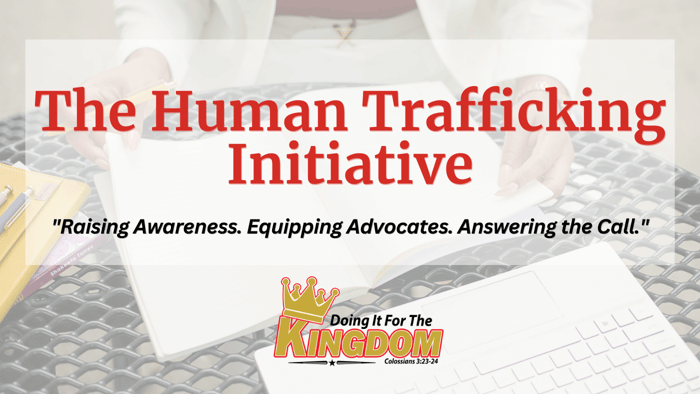Table of Contents
On the Road to Awareness: Understanding Human Trafficking in the Trucking Industry
On the Road to Awareness: Understanding Human Trafficking in the Trucking Industry
 When we think about human trafficking, we often imagine secret operations or hidden corners of society. But the reality is that this global issue frequently intersects with one of the most visible and vital parts of our economy: the trucking industry. Highways, truck stops, rest areas, and freight yards have become key locations for both trafficking activity and frontline interventions.
When we think about human trafficking, we often imagine secret operations or hidden corners of society. But the reality is that this global issue frequently intersects with one of the most visible and vital parts of our economy: the trucking industry. Highways, truck stops, rest areas, and freight yards have become key locations for both trafficking activity and frontline interventions.
In this blog, we’ll explore how human trafficking happens within and around the trucking world, recent real-life cases, signs to look for, and the organizations leading the charge to end this form of modern-day slavery.
Why the Trucking Industry Is a Hotspot for Trafficking
The trucking industry is massive, employing millions of drivers and facilitating the transport of goods across every region in the U.S. and beyond. Unfortunately, traffickers exploit the isolated nature of life on the road and the high traffic moving through transportation hubs.
Victims—especially minors—are often moved from state to state and exploited at rest stops, motels, gas stations, and truck stops. In many cases, traffickers target these areas because of:
Limited oversight and high turnover
Transient populations are less likely to report crimes
Long stretches of unmonitored highway
24/7 operations, making detection difficult
However, it’s not only that victims are brought to truck stops—it’s also that some trucking professionals have been implicated in trafficking rings, either through active participation or failure to report suspicious activity.
How Trafficking Happens in Trucking Spaces
Trafficking in and around the trucking industry typically involves sex trafficking, but labor trafficking is also a growing concern. Here's how it shows up:
1. Victims Transported for Commercial Sex
Traffickers may transport victims in tractor-trailers and force them to engage in commercial sex at rest stops or trucker-friendly motels. These victims are often underage, vulnerable, or undocumented.
2. Coerced Labor Among Drivers
Some immigrant drivers are exploited through false job offers, forced to drive without proper rest, and threatened with deportation or harm if they try to leave. This is a form of labor trafficking.
3. Online Recruitment and Coordination
Traffickers use classified ads, encrypted apps, and online forums to arrange “dates” with truck drivers or to coordinate movement across state lines.
Real-Life cases of Trafficking Involving Trucking
✦ Iowa Truck Stop Case (2023)
In early 2023, law enforcement arrested a man at a truck stop in Iowa for trafficking two minors he had advertised online. Both victims were runaways and had been forced into sex acts in multiple states. The perpetrator used truck stops to conceal his movements and avoid detection. 
✦ Texas Human Trafficking Bust (2022)
In Houston, Texas, authorities dismantled a trafficking ring operating out of several truck stops and motels along I-10. Victims were regularly transported between cities using semi-trucks and were advertised through illicit websites.
✦ Ohio Trucking Company Investigation (2021)
A mid-size trucking company in Ohio was investigated after several employees came forward about undocumented drivers working under coercion. The drivers were paid below minimum wage, had their documents confiscated, and faced threats of violence.
These stories highlight both the dangers and the opportunities: truck stops can be a place of harm or a place of rescue, depending on who’s paying attention.
Organizations Making a Difference
Thankfully, many nonprofits and advocacy groups are working to equip truckers to recognize and report trafficking. Here are some leading voices:
1. Truckers Against Trafficking (TAT)
Perhaps the most well-known organization in this space, TAT, trains truck drivers, and trucking companies to identify signs of trafficking and report them. Their Freedom Drivers Project is a mobile exhibit that travels the country to raise awareness.
Over 1.5 million drivers trained
More than 2,000 reports made through the hotline
Works with schools, law enforcement, and the trucking industry
Website: https://truckersagainsttrafficking.org
2. National Human Trafficking Hotline
It provides 24/7 support for victims and allows anonymous tips. Many truckers now keep the hotline number in their cabs.
Call: 1-888-373-7888
Text “HELP” to 233733
Website: https://humantraffickinghotline.org
3. Coalition to Combat Human Trafficking in Transportation (CCHT)
Launched by the U.S. Department of Transportation, this initiative encourages public-private partnerships and training programs for transit workers, airport staff, and truckers.
Website: https://www.transportation.gov/stophumantrafficking
Warning Signs for Truckers and Bystanders
Whether you're a truck driver, law enforcement officer, or simply someone traveling on the highway, here are some signs of trafficking to watch for:
A young person who appears scared, confused, or under control of another
A person who avoids eye contact and lets someone else speak for them
A minor in a situation that seems inappropriate for their age
Unusual activity in a vehicle or room, especially late at night
Branding or tattoos that say “Daddy,” “Property of,” or barcodes
Individuals with no ID or personal belongings
What You Can Do to Help
You don’t have to be in law enforcement to make a difference. Here’s how you can take action:
1. Educate Yourself
Take the free online training from Truckers Against Trafficking
Read survivor stories to understand trauma-informed language
Subscribe to blogs like The Human Trafficking Initiative for updates
2. Spread the Word
Share hotline information in truck stops, community boards, or social media
Host a training event or invite a speaker to your trucking company, church, or civic group
3. Be Watchful and Report
Keep the National Human Trafficking Hotline number visible
Report any suspicious behavior—even if you’re unsure
Encourage your employer to become a TAT-trained fleet
4. Pray and Partner
Ask God to reveal trafficking operations and protect victims
Support nonprofits fighting for freedom through giving or volunteering
Final Thoughts
The fight against human trafficking isn’t reserved for law enforcement or politicians—it belongs to all of us. With the proper training and a watchful eye, truckers and everyday travelers can become powerful allies in the movement to end exploitation.
Every mile matters. Every report counts. Every life is worth saving.
Whether on the road or supporting from home, you are part of this mission. Join us at Doing It For the Kingdom and stay connected with tools, training, and truth.
Together, let’s make highways safe not just for freight—but for freedom.
FAQs
1. How does human trafficking occur in the trucking industry?
Human trafficking intersects with the trucking industry mainly through the use of truck stops, motels, and rest areas for sex trafficking operations. Traffickers often move victims between states using commercial trucks. In some cases, labor trafficking occurs when drivers are forced to work under exploitative conditions, including withheld wages or threats of deportation.
2. What are the warning signs of trafficking at truck stops or rest areas?
Signs of human trafficking may include individuals who appear fearful, malnourished, or unable to speak for themselves, minors in inappropriate environments, frequent comings and goings at a vehicle or motel room, and branding tattoos such as “Daddy” or barcodes. Victims may also lack ID and show signs of physical abuse or exhaustion.
3. What should truck drivers do if they suspect human trafficking?
If a truck driver witnesses suspicious behavior, they should immediately report it to the National Human Trafficking Hotline at 1-888-373-7888 or text “HELP” to 233733. Truckers can also take free training through organizations like Truckers Against Trafficking (TAT) to learn how to recognize and respond safely.
4. Are there organizations that train truckers to fight trafficking?
Yes. Truckers Against Trafficking (TAT) is the leading nonprofit that educates trucking professionals on how to recognize trafficking. Other organizations, such as the Coalition to Combat Human Trafficking in Transportation, the National Human Trafficking Hotline, and faith-based groups like Doing It For the Kingdom, also provide resources and support.
5. How can the trucking industry help prevent human trafficking?
The industry can take a proactive stance by requiring anti-trafficking training for drivers, posting hotline numbers in cabs and at truck stops, developing policies to protect vulnerable employees, and partnering with nonprofits to promote awareness. Employers can also encourage their teams to report suspected trafficking and support survivor-centered initiatives.


